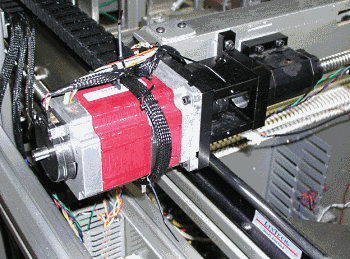|
|
In the center of Opto 22’s Temecula, Calif. factory sits the G4 Handler, a large machine used for final assembly and testing of all of the company’s G4 single point input/output modules that send and receive digital signals. Like most of the company’s modules, G4’s are guaranteed for life. To make this guarantee, the modules are rigorously tested by the machine before they are shipped to customers.
Built by Ron Schmidt, manufacturing engineer, the G4 machine individually tests each and every module twice. A large tray feeds fifty modules. The trays move back and forth and left and right on X and Y axes, while the machine puts each module through several tests. The tests include an
in-rush current test, minimum and maximum current load tests, as well as inductive, capacitive, and resistive tests, which ensure that the modules can handle signals for varying types of electrical equipment such as transformers, power supplies, motors, and lights.
Ensuring that the trays move fluidly back and forth were multiple servoelectric motors coupled with a position feedback device. After two decades of service, the servos began to fail and needed to be replaced. Unfortunately, Schmidt and the maintenance engineers could not find an economical replacement. The decision was made to replace the servomotors with step motors. This type of switch is somewhat uncommon but it is a viable and affordable option.
The upgrade coincided with the release of Opto 22’s SNAP PAC Motion Control Subsystem, which integrates seamlessly in motion control applications that use steppers, such as winding, cut-off, assembly, and packaging.
With a combination of other SNAP products, including the PAC programmable automation controller, Motion Communication Module, Motion Breakout Board, and PAC Control—the control programming component of the PAC Project™ software suite—the motion control subsystem achieves multi-axis step motor control along with traditional analog, digital, and serial-based automation.

|
| The G4 Handler is a large machine used for final assembly and testing of G4 single point input/output modules. After long service, the servos needed to be replaced. An economical servo replacement was not available, so the engineers chose to switch to step motors. |
“Operation of the G4 Handler already included many digital functions,” said Schmidt. “With a clear need for step motion as well, we knew it was an ideal opportunity to test drive the motion subsystem in a quirky situation where we would be embedding SNAP PAC I/O in a machine used to test G4 I/O.”
Schmidt worked with Nick Riley, the engineer who developed the motion subsystem, to match equivalent step controllers with enough torque to adequately move the machine components. “For verification purposes, we needed steppers with encoders,” explained Riley.
Meanwhile, Schmidt stripped out the servos and redressed the belts and harnesses that help move trays side to side and back and forth on the X and Y axes. Next, the old I/O system was
replaced with the new SNAP PAC dense and versatile multi-channel I/O, which provided 16 times the density of the old version. Overall consolidation was considerable and Schmidt was able to squeeze the functions of six single-channel bricks down to a single rack.
The SNAP PAC also handles the bolt feeder activation that inserts a small
securing screw into each module,control of the air cylinders that rise up and down as they apply the high voltage test heads to the modules, and miscellaneous analog functions.
It also controls the Motion Control Subsystem. The Motion Communication Module resides on the same rack as the digital and analog modules and uses an RS-485 serial interface to connect to a breakout board that connects to and drives the machine’s step motors to move the tray tables.

|
| Taking over the duties formerly performed by a servomotor, a step motor ensures the large feed trays move back and forth and left and right on X and Y axes while the machine puts each I/O module through tests. Step controllers were selected with enough torque to move the components. SNAP PAC I/O is part of the motion system used in this quirky situation where Opto 22 products are used to make and test other Opto 22 products. |
In this application, one of the major benefits is the ability to consolidate all I/O functions in one cohesive platform,” said Schmidt. “You don’t need multiple devices or components to handle typical digital points—like a machine’s limit switches—and then another system for recording analog readings—like machine temperatures—and then a third system to execute the machine’s motion control. With the Opto platform, all sensor and component interfaces and all control is performed by one system and all functions are defined using a single development system.”
The motion control subsystem was programmed with PAC Project. It includes a programming tool with scripting and flowcharting, an HMI development application, debugging tools, and the OptoMotion command set, which supports several Magellan™ Motion Processor commands. Kathy Spignese from the Product Support Team used the commands to define the G4 motion process parameters, including position, velocity, acceleration, and time delays for the trays as they move back in forth into proper position for testing.
“For the stepping, I programmed the subsystem to position the trays underneath the test heads so, in succession, each module can be properly tested,” explained Spignese. “I was also able to specify smooth stops or abrupt stops as needed.” Spignese also programmed the system to record module test results.
While outfitting the G4 Handler, Schmidt made a few other changes to enhance efficiency and use, including making all the controls more accessible. A good deal of internal space was saved by rewiring these controls to an OptoTerminal-G70 operator interface terminal. The terminal serves as a central control interface—installed at shoulder-level—from which all machine controls are more easily reached.
Opto 22
www.opto22.com
:: Design World ::
Filed Under: Motion control • motor controls, Motors • servo, Motors • stepper





Tell Us What You Think!